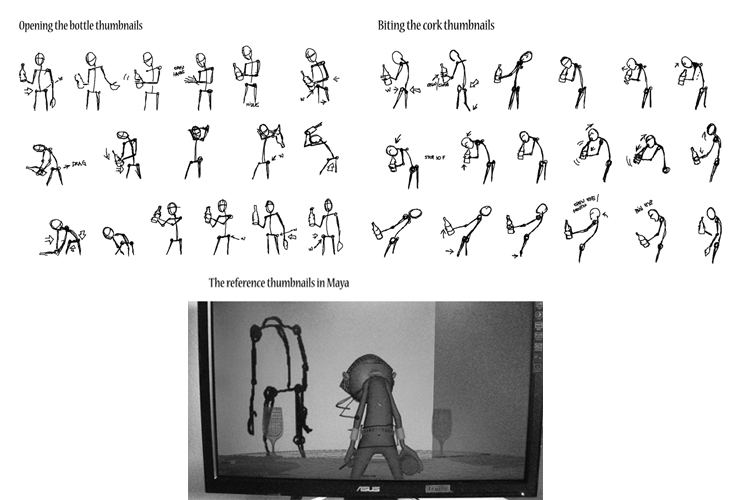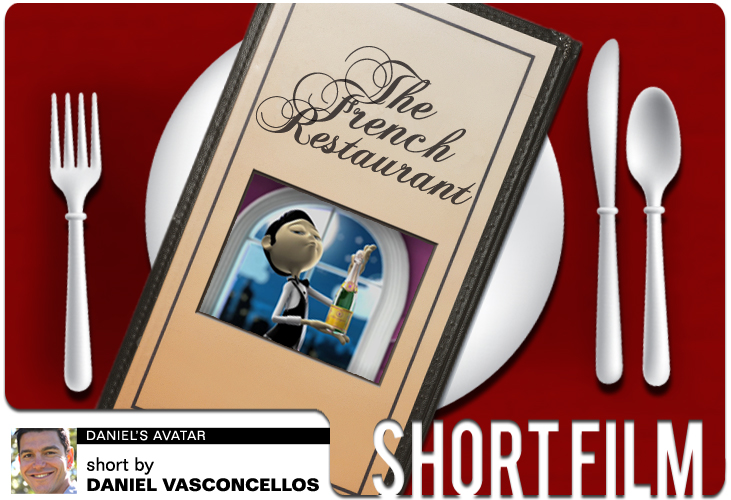The French Restaurant: A Short Film by Animation Mentor Alumnus Daniel Vasconcellos
Please download Flash Player 10 to view video.
Download at http://get.adobe.com/flashplayer/
Animation Mentor:
How did you come up with the concept for your short film?
Daniel Vasconcellos:
When I started Class 5, I was struggling to come up with an idea for my short movie. Then, three friends and I were out to dinner, and we came up with the idea of having a waiter struggling to open a champagne bottle.
Carl Brunker helped me a lot polishing the idea, giving me options to create a script that was more interesting and appealing.
Animation Mentor:
What important lessons did you learn from making your short film?
Daniel Vasconcellos:
Always plan your shots and listen to your mentor's opinion. Always get feedback from friends and peers. Another great piece of advice is to think of your short as an entire piece, not just one shot. Watch it every time and see if all the shots are working well TOGETHER in order to sell the story line.
Animation Mentor:
What was the best piece of advice you received from your mentor or your peers?
Daniel Vasconcellos:
After finishing Class 6, I remember reading in the Animation Mentor newsletter an AM Alumni saying that he never would have finished his short if he didn't schedule time to work on it every day. That's so true! I never would have gotten my short done if I hadn't followed a schedule and worked on it daily!
Animation Mentor:
What were the steps in your planning process?
Daniel Vasconcellos:
First, I draw some thumbnails of the shot's idea, then I shoot video reference of myself in order to get the best performance of the idea. After that, I import the video into a 2D software and draw all the main poses and transition poses based on the video reference, using just a basic stick man shape, and writing down all information of the movements, etc. Last, I import that sequence in the Maya camera, then pose the character following the thumbnails.
Then, when the action poses are blocked, I start to polish the poses and work with the timing.
Animation Mentor:
Do you mind sharing some of the pre-production work with us with a little explanation of what we're looking at?
Daniel Vasconcellos:
Please download Flash Player 10 to view video.
Download at http://get.adobe.com/flashplayer/
A) The Pitch: The short was rough at this point. I polished this idea a lot and simplified the script.
Please download Flash Player 10 to view video.
Download at http://get.adobe.com/flashplayer/
B) The Animatic: This was so fun to do! I start designing the characters at this point too. I worked a lot with cameras and editing after this Animatic process.
Please download Flash Player 10 to view video.
Download at http://get.adobe.com/flashplayer/
C) The Layout: Watching the layout now, I can see that it is very different from the final piece! That's because I had some issues with the camera when the waiter turned his back to the table. It wasn't interesting and was not that funny having EXTRA cameras showing him biting the cork. My Class 6 mentor, James Chiang, gave me the idea of keeping the same camera showing the character turning back, then biting the cork, etc. It's so much better like that! However, I had to re-block that huge sequence again. But it was definitely worth it.

D) Thumbnail process: This is the blocking process that I follow. I shot myself, so this video works as a reference for the thumbnails, which I import into Maya's camera to get the blocking working right and faster.
Please download Flash Player 10 to view video.
Download at http://get.adobe.com/flashplayer/
E) The Blocking Pass: This is the blocking pass with the 5th shot re-blocked. In my workflow, I always watch my short, then try new ideas in the sections that I thought necessary. In the first shot, for example, there was a pan from left to right that I changed for a minimal zoom-in. The second shot is a bit wider showing the three characters all the time. In this section I cut from that shot to a close shot of the waiter. With that change, I focused the action on the main character. At least, I added two extra cameras between the fifth shot; the waiter's point of view looking for the knife in the table, and the waiter's close-up shot when he's stabbing the bottle.
Please download Flash Player 10 to view video.
Download at http://get.adobe.com/flashplayer/
F) The Polishing Pass: This is the last animation polishing pass before the texturing, lighting and rendering process.
Animation Mentor:
What obstacles, if any, did you experience during the creation of your short film? How did you work your way around them?
Daniel Vasconcellos:
After six to seven months working on my short, I realized that I wasn't even close to finishing it. I got to the point where I was even thinking about giving up, to work on another shot, etc. One day, I grabbed a photograph of my niece and nephew and put it on my desk. I knew that they would love my short and that was my ultimate goal. I'm so glad now that they liked it!
Also, the animation polishing process was, for me, the most challenging part. In the main action shot, polishing the animation, I had more than 800 play blasts to get that performance done in a believable way. I had a lot of support from my mentor, James Chiang, who always gave me solutions and ideas, mostly to get the body mechanics working right.
Another big challenge was designing the restaurant set. I was looking for a fancy but still cartoony restaurant look, which was so hard to design! A friend of mine helped me to create the first shot's concept. From there, I used the first shot as a reference look in the others.
Animation Mentor:
How did Animation Mentor help you create your short film?
Daniel Vasconcellos:
Animation Mentor was an amazing experience for me. At the school I got all the support, tools and methodology to grow as animator. The lectures, the mentors, the characters and tools, everything at Animation Mentor is great!
Animation Mentor:
What advice do you have for other students who haven't started their short film yet?
Daniel Vasconcellos:
Believe in your script and bring your own experiences to it. Be personal and your animation will reach people in a unique way. And the most important thing: Never give up. There is no better feeling than seeing people enjoy something that you created.

